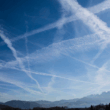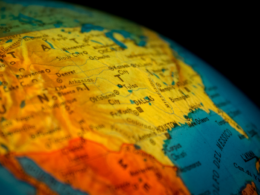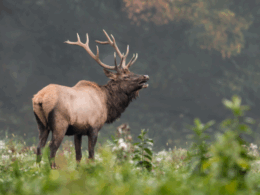A consent application was recently submitted to New Zealand’s Department of Conservation to permit incidental encounters between tourist and migrating Humpback Whales in the coastal waters of Fiordland. This raises some important questions that will need to be carefully considered in the consent process.
TRANSCRIPT
Last week I read in the Otago Daily Times online about an interesting development in marine tourism in New Zealand, specifically relating to tourist interactions with marine mammals in the wild. It noted that Real Journeys Ltd’s (trading as RealNZ) has submitted an application to renew its permit with one major amendment. That is to be permitted to view marine mammals by boat in Fiordland, Southland (Murihiku) and Stewart Island. The amendment, if approved, would allow RealNZ vessels that take visitors on scenic tours in the south-west of the South Island to take advantage of incidental encounters of whales should such opportunities occasionally arise. Essentially – if boats encounter whales during tours – they seek to be able to stop and view those animals. The application is to be able to do so for short periods of time – 15 minutes only – and would apply to sightings of humpbacks, southern right whales and orcas.
The application notes that it is rare to see whales off the Fiordland coast and the permit would only cover occasional incidental sightings. RealNZ chief tourism officer Hannah Ballantyne commented in the ODT article that during whale migration periods there is a possibility that the company’s vessels might encounter whales as they travelled between the east coast of Australia and Antarctica. A permit would mean that on infrequent occasions when encounters occur passengers would be able to experience a rare interaction with whales. The Department of Conservation has called for public submissions on this application.
So what are some of the issues as framed within the broad context of sustainable tourism?
Firstly, in terms of whale watching in Aotearoa New Zealand. Currently, Kaikōura is the only place in New Zealand where commercial whale watching is available to tourists. This has long been a very closely a carefully managed operation. Here Whale Watch Kaikōura is the sole permit holder – a deliberate decision that has been critical to preventing the proliferation of commercial operations. The proliferation of whale watch businesses has been problematic in other parts of the world where whale watching has often been poorly regulated and largely unmanaged.
Whale Watch Kaikōura operates in close collaboration with Te Papa Atawhai, the Department of Conservation. This business is world leading. Its operations are informed by marine science research that aims to identify and mitigate the potential negative impacts of whale encounters. Furthermore, Whale Watch Kaikōura is a business with a long term, intergenerational commitment to the protection of whales, community economic development, and enhancing cultural values. That is a powerful combination.
Second, there are important questions about the impact of whale watching on cetaceans -whales and dolphins.Dr. Rochelle Constantine is a Professor of Marine Biology at the University of Auckland – and the go to person on all matters relating to whales and whale watching in New Zealand. She was interviewed for the ODT article. Rochelle noted that Humpback whale populations have rebounded since the end of commercial whaling. It is amazing to witness the recovery of the Southern Humpback whale populations, which offer reassurance of the capacity of nature to rebound if given the opportunity through protection and conservation measures.
For me personally a highlight of living on the Australian eastern seaboard is the opportunity to view migrating whales close to the coast from shoreline vantage points, in autumn and spring each year. I was visiting Byron Bay recently with friends from New Zealand and from the Byron Bay lighthouse we saw many whales migrating north to give birth to their calves in tropical waters during the winter months.
There we observed a citizen science project that encouraged people to record the time of their observations of migrating whales. The information board noted that the population of Humpback Whales is now thought to have returned to its estimated pre-industrial hunting baseline – estimated to be 45,000 animals. That is a great conservation success story given that whale hunting continued into our own lifetimes. Yesterday I was chatting to an old family friend on the Gold Coast how had vivid early memories of the whale bells sounding on Norfolk Island in the late 1950s. In the 1970s when industrial whaling finally ended in Australia the eastern Humpback whale population had been reduced to only 300 surviving animals. A key point made by Rochelle is that with populations recovering incidental encounters have become increasingly likely and will no doubt become more frequent in future.
If so we can anticipate that we are likely to see more vessel traffic and more tourists in the vicinity of migrating whales – and we need to think carefully about what that might mean for whales. There is plenty of research that highlights potential concerns when boat traffic and migrating whales interact. Injuries from vessel strikes that are sometimes fatal have become more common where the volume and speed of marine traffic increases. The first comprehensive study of vessels strikes on North Atlantic right whales showed the injuries caused by vessel strikes came much more common with increasing vessel traffic. In the tourism context research in Hawaii has indicated that vessel strikes often involve younger animals and calves and increase during the breeding season. Increasing tourist marine traffic and increased boat speeds in Hawaii were key factors in increasing reports of observed vessel strikes.
Vessel strikes aside, extensive field-based behavioural studies conducted over the last 35 years have conclusively shown that cetaceans behave evasively when approached by whale-watching boats. Whale and dolphin populations tend to perceive interactions with boats as a risk. They respond with changes in behaviour that are typical of predator avoidance. Groups of animals often tighten when boats are present or engage in active avoidance by way of changes in movement patterns, increases in dive intervals and increases in swimming speed. If so – the key question that arises is whether or not these behavioural changes are biologically significant – in other words, do observed changes in behaviour risk compromising individual or population health. The nature, intensity and duration of interactions are key factors that need to be considered.
Biologically significant impacts are most likely if repeated disturbance results in a reduction of time engaged in critical behaviours such as socialising, resting and feeding. Numerous studies in New Zealand and internationally have found evidence of biologically significant behaviour changes in dolphins due to interactions with tourists vessels, which in those cases have drawn the legitimacy of whale watching as a form of sustainable tourism into question.
But wait – it gets more complicated. The potential impacts of tourism on whales and dolphins varies enormously with species and location, particularly between resident coastal populations and migratory pelagic or oceanic species. For example, resident Spinner dolphins in Hawaii feed at night and rest during the day – which is when tourists want to see Spinner dolphins. Without adequate temporal protections the critical resting behaviours of these dolphins are compromised. At Shark Bay in Western Australia female bottlenose dolphins with calves were found to react to the presence of vessels on the water before males and a threshold of tourism operators was found, beyond which impacts on females with calves significantly increased.
The current RealNZ consent application relates primarily to encounters with a pelagic migratory species – Humpback Whales – which are subject to their own unique biological circumstances. Females are heavily pregnant when migrating north in winter to birth in tropical waters. In the spring when they migrate south to return to the Southern Ocean, they have been without food for 5-6 months while expending huge energy on lactation, and are travelling south with their recently born calves which we know are more prone to vessel strikes.
Despite now long-standing evidence that repeated exposure to tourism causes disturbances that can affect the conservation status of the targeted species, global whale-watching practices continue in many parts of the world to be conducted in the general absence of strict and enforced regulations. It has generally been assumed that the effects of whale watching do not adversely impact the survival or reproduction of whales and dolphins. Accordingly, these effects have received lower management priority than impacts that pose more immediate threats, such as fisheries by-catch and vessel strikes.
So, given the increasing population of whales in recent decades, and therefore the increasing likelihood of vessel encounters, is this the thin end of the wedge? In other words, is a permit to take advantage of infrequent incidental encounters a stepping stone to more full whale watching permits in New Zealand?
When interviewed by the ODT, Rochelle Constantine commented that when Humpback whales are migrating from Antacrtica up the east coast of Australia, an unknown number, but at least a portion, come through New Zealand waters, and that the likelihood of opportunistic encounters with whales migrating near the Fiordland coast has definitely increased. She also commented that the impact tourism had on the whales and dolphins is well researched and documented. No further research is needed. She confirmed that encounters occur when the whales are at their most vulnerable – migrating females with newborn calves – so “we have to be really mindful of not adding stress to them”.
Fortunately all encounters with marine mammals in New Zealand – tourism or otherwise – are managed under the Marine Mammal Protection Act 1992 and Marine Mammal Protection Regulations. These regulations govern boat approach directions, approach speeds, approach distances and time spent in proximity with whales or dolphins. Under the regulations boats are not allowed closer than 50m to a whale and 200m to a female with a calf. Rochelle expects that DOC will take everything into careful consideration in accordance with the Marine Mammal Protection Act and I am sure that this will be the case.
****
As an important footnote, I attended the TIA Summit in Auckland last year, including the Gala Dinner and the TIA tourism industry awards. The awards evening was a spectacular success for RealNZ. Early in the evening RealNZ received the KiwiRail Tourism Environment Award. It was noted that RealNZ has led projects such as ‘Predator Free Maunga’ at Cardrona and Treble Cone, the Kārearea Project, ‘Plant a Seed,’ and partnerships with the Kea Conservation Trust. It has a memorandum for a predator-free Rakiura Stewart Island, with its Fiordland and Rakiura teams actively trapping predators. At Walter Peak High Country Farm, environmental restoration programmes include wilding pine removal, trapping, re-planting, soil health, organic farming, and eco-tours.
Not bad for starters. But within half an hour RealNZ had also won the Johnston’s Coachlines Tourism Excellence Award in the Large Business category. Its citation noted that RealNZ’s purpose is to “help the world fall in love with conservation through extraordinary experiences in nature” with offerings including water adventures, dining, eco-experiences and skiing. I was sitting at the same table as the RealNZ team for the awards dinner, and so I had a front row seat to witness their success.
And then to top it off, at the end of the evening RealNZ received the Air New Zealand Supreme Tourism Award. It received the supreme award because “since its founding in 1954 by conservation pioneers Les and Lady Olive Hutchins, RealNZ has maintained a rich heritage of fostering appreciation for New Zealand’s natural places, while working to regenerate ecosystems and protect Aotearoa’s natural treasures for future generations.
****
There can be little doubt about the commitment of RealNZ to doing the right thing when it comes to environmental sustainability. It is a longstanding leader in tourism and environmental conservation in tourism in Aotearoa, and a global leader in sustainable and restorative tourism.
And to be honest, I think that it is very creditworthy that a company identifies the growing potential for incidental encounters with marine mammals, and the need to be permitted to engage in those encounters. Other companies would perhaps seek to avoid the effort required to seek a permit and leave incidental encounters as exactly that…. incidental. I would rather have these encounters declared and conducted in accordance with the Marine Mammal Protection Regulations, than not. There will always be question of compliance with permit conditions and regulations, as in the case of the fisheries industry, and this of course should be carefully considered in the current application process.
So bravo to RealNZ for declaring that incidental encounters are taking place and for seeking a permit to ensure that those encounters are conducted in accordance with the Marine Mammal Protection Regulations.
Bravo to Rochelle Constantine, for making sure that research insights from marine science and behavioural ecology are informing consent processes and media reporting. She has been a spokesperson for whale and dolphin watching for many years and this is a public engagement role of critical importance.
And bravo to DOC for overseeing a public submissions process. A key question will be how to manage these encounters if – in future – more migrating whales are likely to be interacting more frequently with tourist vessels in open waters.
References
- Otago Daily Times (2025). Tourism firm seeks right to stop for whale encounters. Ella Scott-Fleming. 16 July 2025. https://www.odt.co.nz/southland/the-ensign/tourism-firm-seeks-right-stop-whale-encounters
- Bejder, L., Samuels, A. M. Y., Whitehead, H. A. L., Gales, N., Mann, J., Connor, R., … & Krützen, M. (2006). Decline in relative abundance of bottlenose dolphins exposed to long‐term disturbance. Conservation Biology, 20(6), 1791-1798.
- Fumagalli, M., Guerra, M., Brough, T., Carome, W., Constantine, R., Higham, J.E.S., Rayment, W., Slooten, L., Stockin, K. & Dawson, S. (2021). Looking back to move forward: Lessons from three decades of research and management of cetacean tourism in New Zealand. Frontiers in Marine Science 8: https://doi.org/10.3389/fmars.2021.624448
- Higham, J. E., Bejder, L., Allen, S. J., Corkeron, P. J., & Lusseau, D. (2016). Managing whale-watching as a non-lethal consumptive activity. Journal of Sustainable Tourism, 24(1), 73-90.
- Higham, J.E.S., Bejder, L. & Williams, R. (Eds). (2014). Whale-watching, sustainable tourism and ecological management. Cambridge University Press. 418pp. ISBN: 978-0-521-19597-3.
- Lammers, M. O., Pack, A. A., Lyman, E. G., & Espiritu, L. (2013). Trends in collisions between vessels and North Pacific humpback whales (Megaptera novaeangliae) in Hawaiian waters (1975–2011). Journal of Cetacean Resource Management. 13(1), 73-80.
- Lusseau, D. & Higham, J.E.S. (2004). Managing the impacts of dolphin-based tourism through the definition of critical habitats: The case of bottlenose dolphins (Tursiops spp.) in Doubtful Sound, New Zealand. Tourism Management25(5): 657-667.








